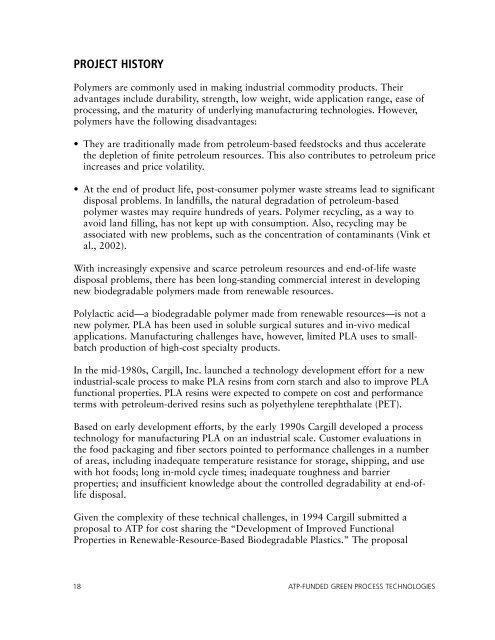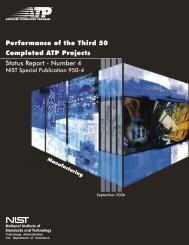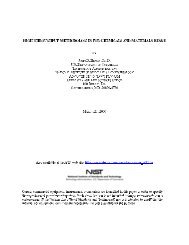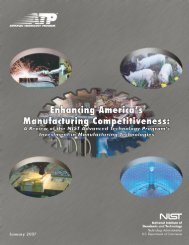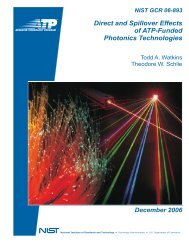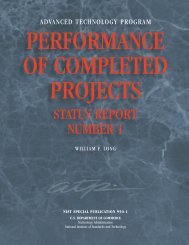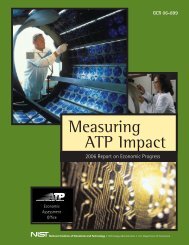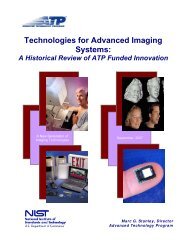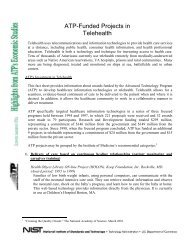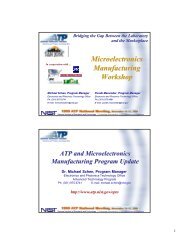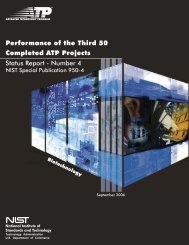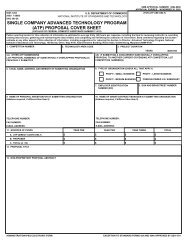ATP-Funded Green Process Technologies - NIST Advanced ...
ATP-Funded Green Process Technologies - NIST Advanced ...
ATP-Funded Green Process Technologies - NIST Advanced ...
Create successful ePaper yourself
Turn your PDF publications into a flip-book with our unique Google optimized e-Paper software.
PROJECT HISTORY<br />
Polymers are commonly used in making industrial commodity products. Their<br />
advantages include durability, strength, low weight, wide application range, ease of<br />
processing, and the maturity of underlying manufacturing technologies. However,<br />
polymers have the following disadvantages:<br />
• They are traditionally made from petroleum-based feedstocks and thus accelerate<br />
the depletion of finite petroleum resources. This also contributes to petroleum price<br />
increases and price volatility.<br />
• At the end of product life, post-consumer polymer waste streams lead to significant<br />
disposal problems. In landfills, the natural degradation of petroleum-based<br />
polymer wastes may require hundreds of years. Polymer recycling, as a way to<br />
avoid land filling, has not kept up with consumption. Also, recycling may be<br />
associated with new problems, such as the concentration of contaminants (Vink et<br />
al., 2002).<br />
With increasingly expensive and scarce petroleum resources and end-of-life waste<br />
disposal problems, there has been long-standing commercial interest in developing<br />
new biodegradable polymers made from renewable resources.<br />
Polylactic acid—a biodegradable polymer made from renewable resources—is not a<br />
new polymer. PLA has been used in soluble surgical sutures and in-vivo medical<br />
applications. Manufacturing challenges have, however, limited PLA uses to smallbatch<br />
production of high-cost specialty products.<br />
In the mid-1980s, Cargill, Inc. launched a technology development effort for a new<br />
industrial-scale process to make PLA resins from corn starch and also to improve PLA<br />
functional properties. PLA resins were expected to compete on cost and performance<br />
terms with petroleum-derived resins such as polyethylene terephthalate (PET).<br />
Based on early development efforts, by the early 1990s Cargill developed a process<br />
technology for manufacturing PLA on an industrial scale. Customer evaluations in<br />
the food packaging and fiber sectors pointed to performance challenges in a number<br />
of areas, including inadequate temperature resistance for storage, shipping, and use<br />
with hot foods; long in-mold cycle times; inadequate toughness and barrier<br />
properties; and insufficient knowledge about the controlled degradability at end-oflife<br />
disposal.<br />
Given the complexity of these technical challenges, in 1994 Cargill submitted a<br />
proposal to <strong>ATP</strong> for cost sharing the “Development of Improved Functional<br />
Properties in Renewable-Resource-Based Biodegradable Plastics.” The proposal<br />
18 <strong>ATP</strong>-FUNDED GREEN PROCESS TECHNOLOGIES


